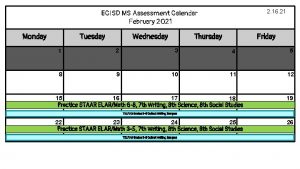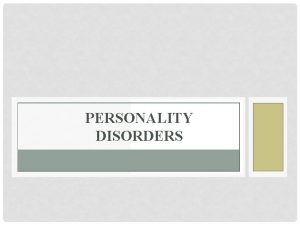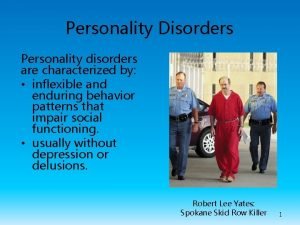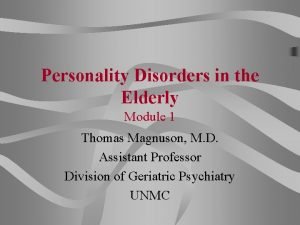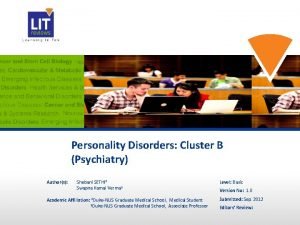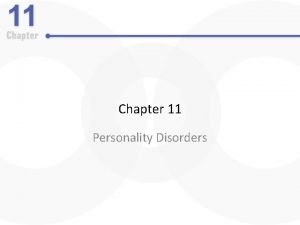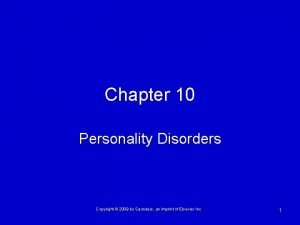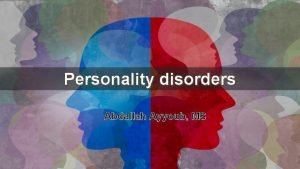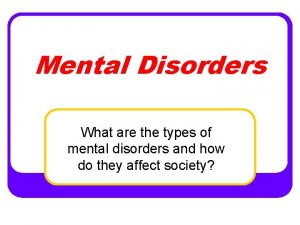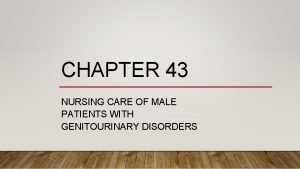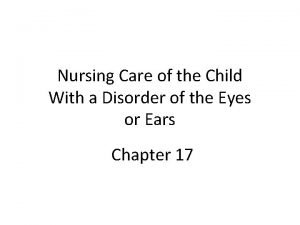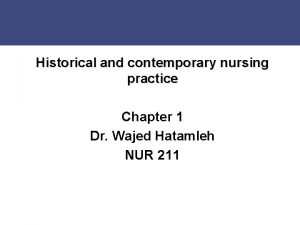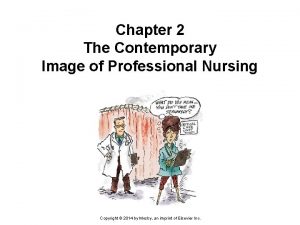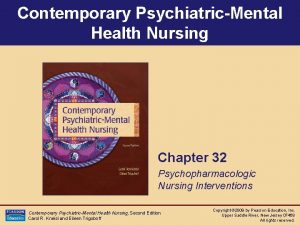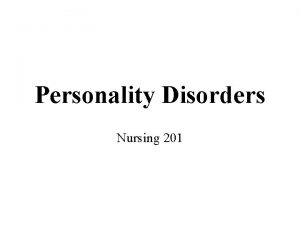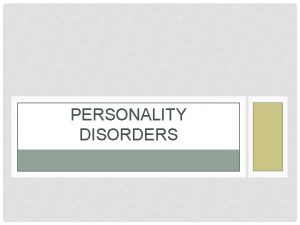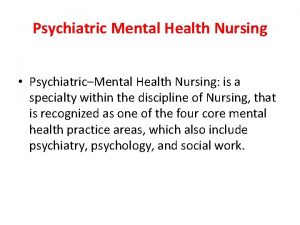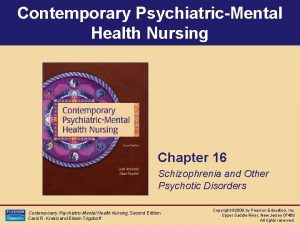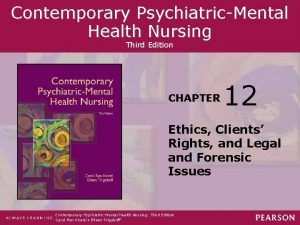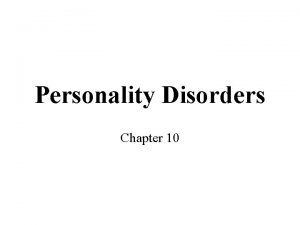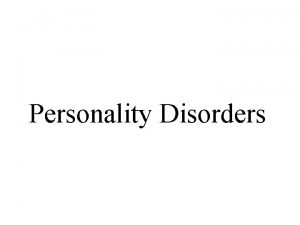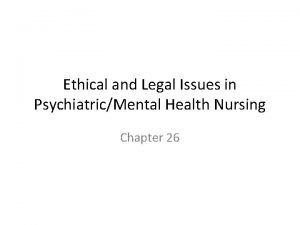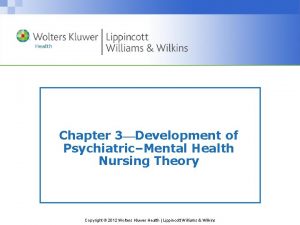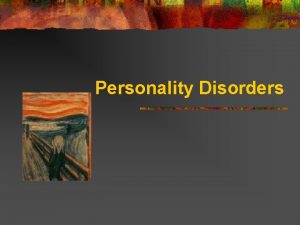Personality Disorders Spring 2011 Contemporary PsychiatricMental Health Nursing





























- Slides: 29

Personality Disorders Spring 2011

Contemporary Psychiatric-Mental Health Nursing Chapter 22 Personality Disorders Contemporary Psychiatric-Mental Health Nursing, Second Edition Carol R. Kneisl and Eileen Trigoboff Copyright © 2009 by Pearson Education, Inc. Upper Saddle River, New Jersey 07458 All rights reserved.

Personality • The individual qualities, including habitual behavior patterns, that make a person unique

Personality Traits • Persistent behavioral patterns that do not significantly interfere with one’s life, even though the behaviors may be annoying or frustrating to others

Personality Disorders • Rigid, stereotyped behavior pattern • Persists throughout the person’s life • Pattern of perceiving, thinking, and relating that impairs social or occupational functioning • Axis II diagnoses

Common Characteristics • Failure to accept the consequences of behavior • Lack of insight • External response to stress

Essential Characteristics • Chronicity • Pervasiveness • Maladaptation

Biologic Factors • Alterations in hormone & platelet monoamine oxidase (MAO) levels • Smooth-pursuit eye movements • Neurotransmitter changes

Biologic Factors - continued • Electroencephalographic (EEG) changes • Structural brain changes • Diminished blood flow and inflammation

Genetic Factors • Familial tendencies • Cluster B correlated with mood disorders, alcoholism, & somatization • Genetic variation

Psychosocial Factors • • • Parent–child interactions Intrapsychic theory Enmeshment Abandonment Identity diffusion

Humanistic Theory • Personality disorders are a combination of multiple factors.

Diagnostic Clusters • Cluster A: Odd–Eccentric – Paranoid – Schizotypal

Diagnostic Clusters - continued • Cluster B: Dramatic–Emotional – Borderline – Histrionic – Narcissistic – Antisocial

Interview with Elizabeth Click here to view a video interview with Elizabeth

Diagnostic Clusters - continued • Cluster C: Anxious–Fearful – Avoidant – Dependent – Obsessive-compulsive

Application of the Nursing Process • • Safety Consistency Boundary setting Appropriate self-disclosure

Difficult Behaviors • Manipulation • Narcissism • Impulsiveness

Interventions for Paranoid Personality Disorder • • Respect personal space. Respect client’s preference. Give feedback based on nonverbal cues. Provide client with a daily schedule of activities and inform client of changes.

Interventions for Paranoid Personality Disorder continued • Help client identify adaptive diversionary activities. • Use role-playing. • Use an objective, matter-of-fact approach with client. • Use concrete, specific words rather than global abstractions.

Interventions for the Angry Client • • • Use a calm, unhurried approach. Do not touch client indiscriminately. Respect personal space. Use active listening skills. Remain aware of personal feelings.

Interventions for Antisocial Personality Disorder • Use a concerned, matter-of-fact approach. • Set, communicate, and maintain consistent rules and regulations. • Do not argue, bargain, or rationalize.

Interventions for the Antisocial Personality Disorder - continued • Confront inappropriate behaviors. • Do not seek approval or coax; use choices and consequences. • Be alert for flattery or verbal attacks.

Interventions for Manipulative Behavior • Assign one primary staff member. • Maintain realistic limits with enforceable consequences. • Give a rationale for limits and consequences.

Interventions for Manipulative Behavior - continued • Model respect, honesty, openness, and assertiveness. • Confront client each time manipulation occurs.

Interventions for Dependent Personality Disorder • Evaluate client’s ability for self-care. • Avoid doing things the client is capable of doing. • Help client identify assets and liabilities.

Interventions for Dependent Personality Disorder - continued • Emphasize strengths and potential. • Encourage client to take responsibility for own opinions. • Point out when client negates own feelings or opinions.

The Nurse’s Response • • Self-awareness Countertransference Labels and stigma Supervision

Resources • http: //www. bpdcentral. com Borderline Personality Disorder Central is an organization with information and resources for people who care about someone who may have borderline personality disorder (BPD). • http: //www. bpdresourcecenter. org The Borderline Personality Disorder Resource Center (BPDRC) at New York–Presbyterian Hospital has been set up to help those impacted by the disorder find the most current, accurate information on the nature of BPD and on sources of treatment. • http: //www. mentalhelp. net/poc/center_index. php? id=8 This Mental Help Net link contains information about personality disorders: types, treatment, research, literature, and resources.
 Ecisd spring break 2011
Ecisd spring break 2011 Body dysmorphia irvine
Body dysmorphia irvine Personality disorder types
Personality disorder types Dramatic personality disorders
Dramatic personality disorders Dsm v personality disorders
Dsm v personality disorders Group c personality disorders
Group c personality disorders Cluster c personality disorder
Cluster c personality disorder Cluster traits
Cluster traits Obsessive personality disorder
Obsessive personality disorder Karla homulka
Karla homulka Cluster b personality disorder
Cluster b personality disorder Antisocial personality disorder mnemonic
Antisocial personality disorder mnemonic Cluster b personality disorders
Cluster b personality disorders Weird wild wacky personality disorders
Weird wild wacky personality disorders Type c personality disorder
Type c personality disorder Cluster c personality disorders
Cluster c personality disorders Kim ki duk summer fall winter spring
Kim ki duk summer fall winter spring Fall winter spring summer months
Fall winter spring summer months Nursing care of male patients with genitourinary disorders
Nursing care of male patients with genitourinary disorders Nursing care plan for conjunctivitis slideshare
Nursing care plan for conjunctivitis slideshare Who analgesic ladder
Who analgesic ladder Pneumatic reduction of intussusception
Pneumatic reduction of intussusception Pathophysiology of intestinal obstruction
Pathophysiology of intestinal obstruction Unit 14 health and social care coursework
Unit 14 health and social care coursework The flinders model
The flinders model Physical disorders and health psychology
Physical disorders and health psychology Chapter 21 mental health diseases and disorders
Chapter 21 mental health diseases and disorders Mental health disorders
Mental health disorders Contemporary nursing definition
Contemporary nursing definition Contemporary professional nursing
Contemporary professional nursing
